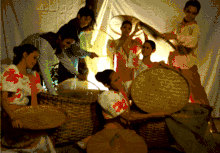Mandarin Chinese in the Philippines
Mandarin Chinese is spoken and taught academically to Chinese Filipinos in the Philippines.[1] Both Standard Chinese and Taiwanese Mandarin are taught and spoken in the Philippines, with some schools and speakers using Simplified Chinese characters, some using Traditional Chinese characters and some using a mixture of both.
| Part of a series on the |
| Culture of the Philippines |
|---|
 |
| People |
| Languages |
| Traditions |
| Cuisine |
| Festivals |
| Religion |
| Art |
| Literature |
|
| Mandarin Chinese in the Philippines | |||||||||||||
|---|---|---|---|---|---|---|---|---|---|---|---|---|---|
| Traditional Chinese | 菲律賓華語 | ||||||||||||
| Simplified Chinese | 菲律宾华语 | ||||||||||||
| |||||||||||||
Classification
Mandarin in the Philippines can be classified into two distinct Mandarin dialects: Standard Mandarin and Colloquial Mandarin. Standard Mandarin is either the standard languages of Mainland China and Taiwan, while Colloquial Mandarin in the Philippines tends to combine features from Mandarin (simplified Chinese: 华语; traditional Chinese: 華語) and features from Hokkien (閩南語) of the local Philippine Hokkien dialect, which is the heritage language of many Chinese Filipinos.[1]
Usage
Only a small minority of Chinese Filipinos claim Mandarin as their native first language, with Tagalog or English typically being the first language.[1] The lack of environment for speaking the language and the difficulty of learning it created not just a lack of interest, but even great disgust by some towards it.[1]
Efforts in the 21st century to promote Mandarin Chinese education in Chinese Filipino institutions and recent utilitarian trends, such as more Mandarin job opportunities, recent immigrants from China or Taiwan, summer education trips to China or Taiwan, encouragement of universities and schools by past presidents, and education exchange deals with China have spurred interest and potential for growth in the usage of Mandarin.[2][1]
Code-switching
Sometimes Chinese Filipinos also code-switch Mandarin together with other languages, such as English, Tagalog (or other Philippine languages), and Hokkien, as a form of pidgin language, just like Hokaglish or Singlish.[1]
Education
In terms of phonology, vocabulary and grammar, the Mandarin taught in the Philippines is often the Taiwanese variety ("Guóyǔ") of Standard Chinese because many Chinese Filipino schools use dictionaries and books from Taiwan. In recent years, some have also began using books and teaching materials from Mainland China, Singapore, and Malaysia. Filipino Mandarin newspapers use the Traditional Chinese characters in writing. Due to selection of founders and sponsors of Chinese schools, schools either teach using only Simplified Chinese characters, only Traditional Chinese characters, or a mixture of both.[3] Many Chinese Filipino schools use pinyin or bopomofo (zhuyin fuhao) to teach the language.[1]
Chinese Filipino schools often use the first language approach, which assumes that students of Chinese Filipino schools have had native experience of Mandarin.[1]
References
- Palanca, Ellen H. (2002). "A Comparative Study of Chinese Education in the Philippines and Malaysia*" (PDF). Asian Studies. 38 (2): 1 – via Asian Studies: Journal of Critical Perspectives on Asia.
- Aguilar, Krissy (May 7, 2019). "Philippines, China to enhance education, cultural exchange for Filipino teachers". Philippine Daily Inquirer.
- Yang, Shimin (2014). Written at Science and Technology College, Jiangxi Normal University. "Several Thoughts on Current Chinese Education in the Philippines" (PDF). Nanchang, China: Atlantis Press. p. 197.